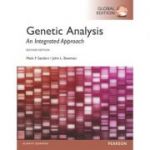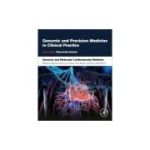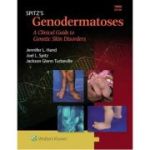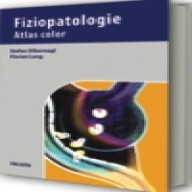Genetic Analysis: An Integrated Approach with MasteringGenetics, Global Edition

DESCRIERE
Informed by many years of genetics teaching and research expertise, authors Mark Sanders and John Bowman use an integrated approach that helps contextualize three core challenges of learning genetics: solving problems, understanding evolution, and understanding the connection between traditional genetics models and more modern approaches.
Genetic Analysis: An Integrated Approach, 2/e is extensively updated with relevant, cutting-edge coverage of modern genetics and is supported by MasteringGenetics, the most widely-used homework and assessment program in genetics. Featuring expanded assignment options, MasteringGenetics complements the book’s problem-solving approach, engages students, and improves results by helping them master concepts and problem-solving skills.
-
Table of Contents
BRIEF CONTENTS
1 The Molecular Basis of Heredity, Variation, and Evolution
1. 1 Modern Genetics Is in Its Second Century
1. 2 The Structure of DNA Suggests a Mechanism for Replication
1. 3 DNA Transcription and Messenger RNA Translation Express Genes
1. 4 Evolution Has a Molecular Basis
Case Study The Modern Human Family Mystery
Summary • Keywords • Problems
2 Transmission Genetics
2. 1 Gregor Mendel Discovered the Basic Principles of Genetic Transmission
2. 2 Monohybrid Crosses Reveal the Segregation of Alleles
2. 3 Dihybrid and Trihybrid Crosses Reveal the Independent Assortment of
Alleles
2. 4 Probability Theory Predicts Mendelian Ratios
2. 5 Chi-Square Analysis Tests the Fit between Observed Values and
Expected Outcomes
2. 6 Autosomal Inheritance and Molecular Genetics Parallel the Predictions
of Mendel’s Hereditary Principles
Case Study Inheritance of Sickle Cell Disease in Humans
Summary • Keywords • Problems
3 Cell Division and Chromosome Heredity
3. 1 Mitosis Divides Somatic Cells
3. 2 Meiosis Produces Gametes for Sexual Reproduction
3. 3 The Chromosome Theory of Heredity Proposes That Genes Are
Carried on Chromosomes
3. 4 Sex Determination Is Chromosomal and Genetic
3. 5 Human Sex-Linked Transmission Follows Distinct Patterns
3. 6 Dosage Compensation Equalizes the Expression of Sex-Linked
Genes
Case Study The (Degenerative) Evolution of the Mammalian Y Chromosome
Summary • Keywords • Problems
4 Inheritance Patterns of Single Genes and Gene Interaction
4. 1 Interactions between Alleles Produce Dominance Relationships
4. 2 Some Genes Produce Variable Phenotypes
4. 3 Gene Interaction Modifies Mendelian Ratios
4. 4 Complementation Analysis Distinguishes Mutations in the Same Gene
from Mutations in Different Genes
Case Study Complementation Groups in a Human Cancer-Prone Disorder
Summary • Keywords • Problems
5 Genetic Linkage and Mapping in Eukaryotes
5. 1 Linked Genes Do Not Assort Independently
5. 2 Genetic Linkage Mapping Is Based on Recombination Frequency
between Genes
5. 3 Three-Point Test-Cross Analysis Maps Genes
5. 4 Recombination Results from Crossing Over
5. 5 Linked Human Genes Are Mapped Using Lod Score Analysis
5. 6 Recombination Affects Evolution and Genetic Diversity
5. 7 Genetic Linkage in Haploid Eukaryotes Is Identified by Tetrad Analysis
5. 8 Mitotic Crossover Produces Distinctive Phenotypes
Case Study Mapping the Gene for Cystic Fibrosis
Summary • Keywords • Problems
6 Genetic Analysis and Mapping in Bacteria and Bacteriophages
6. 1 Bacteria Transfer Genes by Conjugation
6. 2 Interrupted Mating Analysis Produces Time-of-Entry Maps
6. 3 Conjugation with F¢ Strains Produces Partial Diploids
6. 4 Bacterial Transformation Produces Genetic Recombination
6. 5 Bacterial Transduction Is Mediated by Bacteriophages
6. 6 Bacteriophage Chromosomes Are Mapped by Fine-Structure Analysis
6. 7 Lateral Gene Transfer Alters Genomes
Case Study The Evolution of Antibiotic Resistance and Change in Medical Practice
Summary • Keywords • Problems
7 DNA Structure and Replication
7. 1 DNA Is the Hereditary Molecule of Life
7. 2 The DNA Double Helix Consists of Two Complementary and
Antiparallel Strands
7. 3 DNA Replication Is Semiconservative and Bidirectional
7. 4 DNA Replication Precisely Duplicates the Genetic Material
7. 5 Molecular Genetic Analytical Methods Make Use of DNA Replication
Processes
Case Study Use of PCR and DNA Sequencing to Analyze Huntington Disease Mutations
Summary • Keywords • Problems
8 Molecular Biology of Transcription and RNA Processing
8. 1 RNA Transcripts Carry the Messages of Genes
8. 2 Bacterial Transcription Is a Four-Stage Process
8. 3 Archaeal and Eukaryotic Transcription Displays Structural Homology and Common Ancestry
8. 4 Post-Transcriptional Processing Modifies RNA Molecules
Case Study Sexy Splicing: Alternative mRNA Splicing and Sex Determination in Drosophila
Summary • Keywords • Problems
9 The Molecular Biology of Translation
9. 1 Polypeptides Are Composed of Amino Acid Chains That Are Assembled at Ribosomes
9. 2 Translation Occurs in Three Phases
9. 3 Translation Is Fast and Efficient
9. 4 The Genetic Code Translates Messenger RNA into Polypeptide
9. 5 Experiments Deciphered the Genetic Code
9. 6 Translation Is Followed by Polypeptide Folding, Processing, and Protein Sorting
Case Study Antibiotics and Translation Interference
Summary • Keywords • Problems
10 The Integration of Genetic Approaches: Understanding Sickle Cell
Disease
10. 1 An Inherited Hemoglobin Variant Causes Sickle Cell Disease
10. 2 Genetic Variation Can Be Detected by Examining DNA, RNA, and
Proteins
10. 3 Sickle Cell Disease Evolved by Natural Selection in Human Populations
Case Study Transmission and Molecular Genetic Analysis of Thalassemia
Summary • Keywords • Problems
11 Chromosome Structure
11. 1 Viruses Are Infectious Particles Containing Nucleic Acid Genomes
11. 2 Bacterial Chromosomes Are Organized by Proteins
11. 3 Eukaryotic Chromosomes Are Organized into Chromatin
11. 4 Chromatin Compaction Varies along the Chromosome
11. 5 Chromatin Organizes Archaeal Chromosomes
Case Study Fishing for Chromosome Abnormalities in Cancer Cells
Summary • Keywords • Problems
12 Gene Mutation, DNA Repair, and Homologous Recombination
12. 1 Mutations Are Rare and Occur at Random
12. 2 Gene Mutations Modify DNA Sequence
12. 3 Gene Mutations May Arise from Spontaneous Events
12. 4 Mutations May Be Induced by Chemicals or Ionizing Radiation
12. 5 Repair Systems Correct Some DNA Damage
12. 6 Proteins Control Translesion DNA Synthesis and the Repair of
Double-Strand Breaks
12. 7 DNA Double-Strand Breaks Initiate Homologous Recombination
12. 8 Gene Conversion Is Directed Mismatch Repair in Heteroduplex
DNA
Case Study Li-Fraumeni Syndrome Is Caused by Inheritance of Mutations of p53
Summary • Keywords • Problems
13 Chromosome Aberrations and Transposition
13. 1 Nondisjunction Leads to Changes in Chromosome Number
13. 2 Changes in Euploidy Result in Various Kinds of Polyploidy
13. 3 Chromosome Breakage Causes Mutation by Loss, Gain, and
Rearrangement of Chromosomes
13. 4 Chromosome Breakage Leads to Inversion and Translocation of
Chromosomes
13. 5 Transposable Genetic Elements Move throughout the Genome
13. 6 Transposition Modifies Bacterial Genomes
13. 7 Transposition Modifies Eukaryotic Genomes
Case Study Human Chromosome Evolution
Summary • Keywords • Problems
14 Regulation of Gene Expression in Bacteria and Bacteriophage
14. 1 Transcriptional Control of Gene Expression Requires DNA—Protein
Interaction
14. 2 The lac Operon Is an Inducible Operon System under Negative and
Positive Control
14. 3 Mutational Analysis Deciphers Genetic Regulation of the lac Operon
14. 4 Transcription from the Tryptophan Operon Is Repressible and
Attenuated
14. 5 Bacteria Regulate the Transcription of Stress Response Genes and Translation and Archaea Regulate Transcription in a
Bacteria-like Manner
14. 6 Antiterminators and Repressors Control Lambda Phage Infection of
E. coli
Case Study Vibrio cholerae–Stress Response Leads to Serious Infection
Summary • Keywords • Problems
15 Regulation of Gene Expression in Eukaryotes
15. 1 Cis-Acting Regulatory Sequences Bind Trans-Acting Regulatory
Proteins to Control Eukaryotic Transcription
Transcriptional Regulatory Interactions
15. 2 Chromatin Remodeling and Modification Regulates Eukaryotic Transcription
15. 3 RNA-Mediated Mechanisms Control Gene Expression
Case Study Environmental Epigenetics
Summary • Keywords • Problems
16 Analysis of Gene Function via Forward Genetics and Reverse Genetics
16. 1 Forward Genetic Screens Identify Genes by Their Mutant Phenotypes
16. 2 Genes Identified by Mutant Phenotype Are Cloned Using Recombinant DNA Technology
16. 3 Reverse Genetics Investigates Gene Action by Progressing from Gene Identification to Phenotype
16. 4 Transgenes Provide a Means of Dissecting Gene Function
Case Study Reverse Genetics and Genetic Redundancy in Flower Development
Summary • Keywords • Problems
17 Recombinant DNA Technology and Its Applications
17. 1 Specific DNA Sequences Are Identified and Manipulated Using Recombinant DNA Technology
17. 2 Introducing Foreign Genes into Genomes Creates Transgenic Organisms
17. 3 Gene Therapy Uses Recombinant DNA Technology
17. 4 Cloning of Plants and Animals Produces Genetically Identical
Individuals
Case Study Curing Sickle Cell Disease in Mice
Summary • Keywords • Problems
18 Genomics: Genetics from a Whole-Genome Perspective
18. 1 Structural Genomics Provides a Catalog of Genes in a Genome
18. 2 Annotation Ascribes Biological Function to DNA Sequences
18. 3 Evolutionary Genomics Traces the History of Genomes
18. 4 Functional Genomics Aids in Elucidating Gene Function
Case Study Genomic Analysis of Insect Guts May Fuel the World
Summary • Keywords • Problems
19 Organelle Inheritance and the Evolution of Organelle Genomes
19. 1 Organelle Inheritance Transmits Genes Carried on Organelle Chromosomes
19. 2 Modes of Organelle Inheritance Depend on the Organism
19. 3 Mitochondria Are the Energy Factories of Eukaryotic Cells
19. 4 Chloroplasts Are the Sites of Photosynthesis
19. 5 The Endosymbiosis Theory Explains Mitochondrial and Chloroplast
Evolution
Case Study Ototoxic Deafness: A Mitochondrial Gene—Environment Interaction
Summary • Keywords • Problems
20 Developmental Genetics
20. 1 Development Is the Building of a Multicellular Organism
20. 2 Drosophila Development Is a Paradigm for Animal Development
20. 3 Cellular Interactions Specify Cell Fate
20. 4 “Evolution Behaves Like a Tinkerer”
20. 5 Plants Represent an Independent Experiment in Multicellular Evolution
Case Study Cyclopia and Polydactyly–Different Shh Mutations with Distinctive Phenotypes
Summary • Keywords • Problems
21 Genetic Analysis of Quantitative Traits
21. 1 Quantitative Traits Display Continuous Phenotype Variation
21. 2 Quantitative Trait Analysis Is Statistical
21. 3 Heritability Measures the Genetic Component of Phenotypic Variation
21. 4 Quantitative Trait Loci Are the Genes That Contribute to Quantitative
Traits
Case Study GWAS and Crohn’s Disease
Summary • Keywords • Problems
22 Population Genetics and Evolution at the Population, Species, and Molecular Levels
22. 1 The Hardy—Weinberg Equilibrium Describes the Relationship of Allele
and Genotype Frequencies in Populations
22. 2 Natural Selection Operates through Differential Reproductive Fitness
within a Population
22. 3 Mutation Diversifies Gene Pools
22. 4 Migration Is Movement of Organisms and Genes between
Populations
22. 5 Genetic Drift Causes Allele Frequency Change by Sampling Error
22. 6 Inbreeding Alters Genotype Frequencies
22. 7 Species and Higher Taxonomic Groups Evolve by the Interplay of Four
Evolutionary Processes
22. 8 Molecular Evolution Changes Genes and Genomes through Time
Case Study CODIS–Using Population Genetics to Solve Crime and Identify Paternity
Summary • Keywords • Problems
Selected References and Readings
Answers to Selected Problems
Glossary
Credits
Index
Categorii de carte
-Comandă specială
-Edituri
-Promo
-Publicaţii Callisto
-Cărţi noi
-- 787,50 lei
- 1197,00 leiPRP: 1260,00 lei
- 2551,50 leiPRP: 2835,00 lei
Promoţii
-- 1197,00 leiPRP: 1260,00 lei
- 1108,80 leiPRP: 1260,00 lei
- 850,50 leiPRP: 945,00 lei











REVIEW-URI